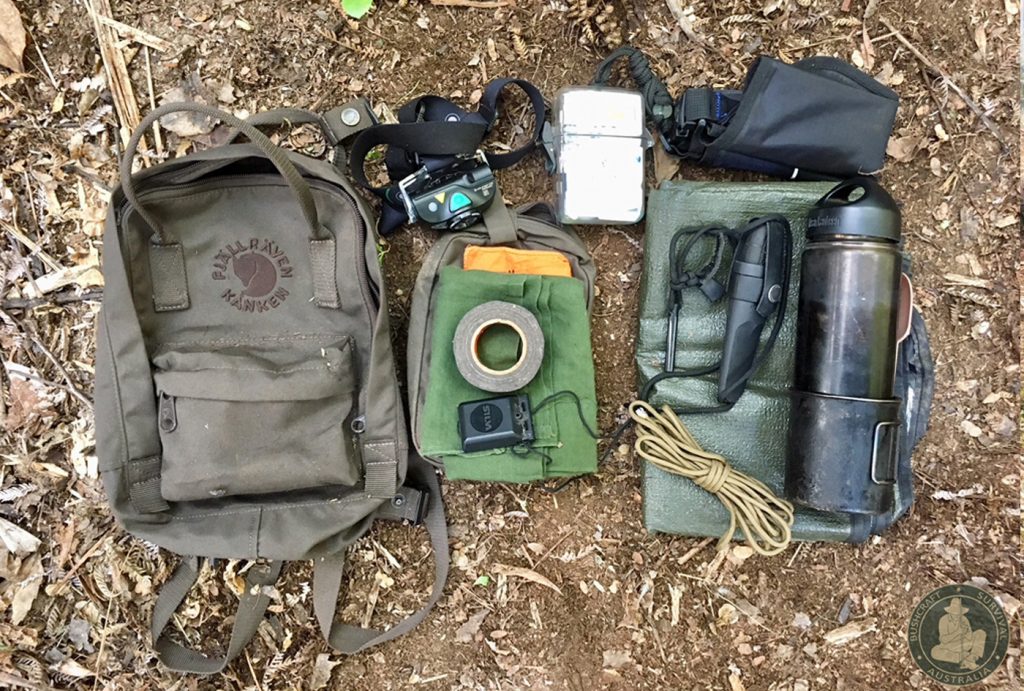
Australia is a vast country and many Australians like to travel off the the beaten track to see wild “untouched” places in order to experienced that feeling of being at one with nature.
However, many people go into these places ill equiped and with insufficient planning in case something goes wrong, often resulting in people getting lost, injured or worse, death! Many people in urban environments are also ill equipped and lack basic knowledge of what to do should an urban crisis or emergency occur.
The most common group of people who seem to get themselves into trouble are the “day hiker or visitor”. This group of people generally think… “She’ll be right, I’ll only be gone for a short time…” These people don’t tell anyone where they are going or when they will return. They don’t take a hat or enough water, don’t take a warm layer, a shelter or have the ability to make a fire.
If you are going into a wilderness area on a planned trip or even a local bushwalk for only a couple of hours, there are two key things you should do first.
1. Tell someone where you are going and when you expect to be back. Even if you are only going on a short day hike for a couple of hours! Have a game plan if you are not back!
2. Dress appropriately. Dress for the environment you are going into. Wear long sleeves and a hat to protect against the sun and have warm layers and a head covering for the evenings.
Below are 12 important items that everyone should have in their daypack when venturing into a wilderness area. Every item should be durable, portable and have multiple uses. The first five items are the most crucial as they are the items that are the most difficult and time consuming to produce in nature if you don’t have them.
Knowing what these items are will help you prioritise what is important and also what to manufacture from nature should you find yourself without them.
These same items and priorities are what you also need in an urban crisis or emergency, only the resources change.
12 IMPORTANT ITEMS
1. Cutting tool ( knife) This is probably the most important tool. Ideally it should be a full tang 5” (11cm) carbon or stainless steel knife without serrations or saws built in to it as these inhibit its practical us. Morakniv make good affordable general purpose knives for the outdoors including the HD Companion, Bushcraft Black, Edris and Garberg. A Leatherman multitool or Victorinox pocket knife is also a good smaller option. To make a cutting tool in nature requires flint and a knowledge of flint knapping.
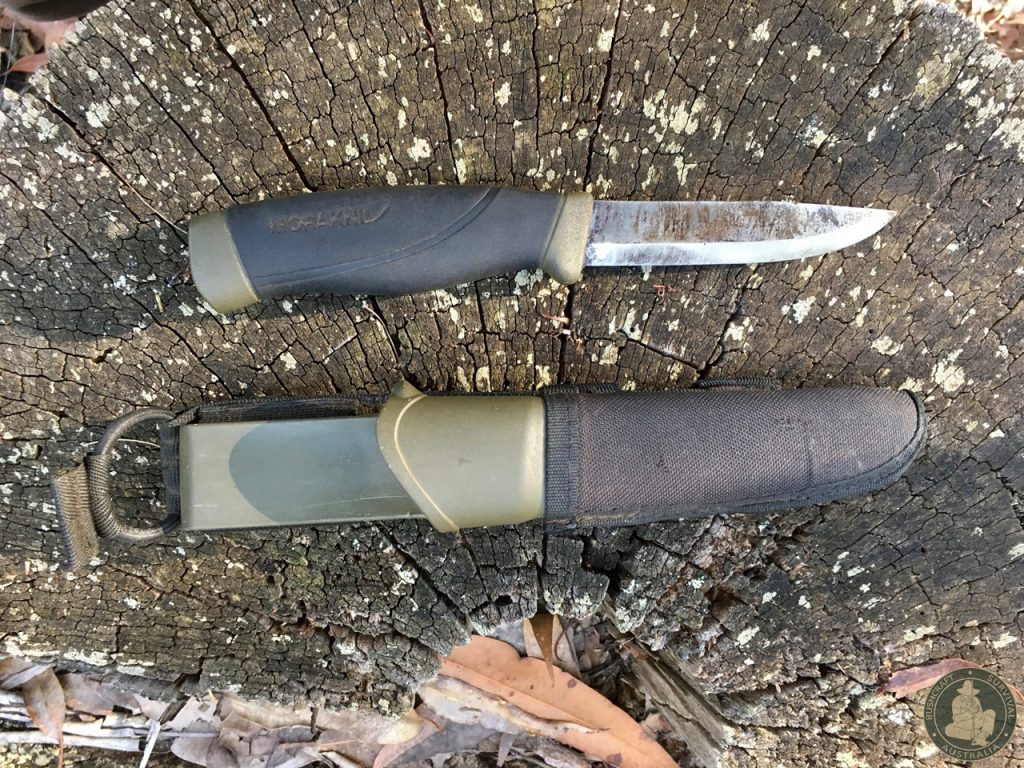
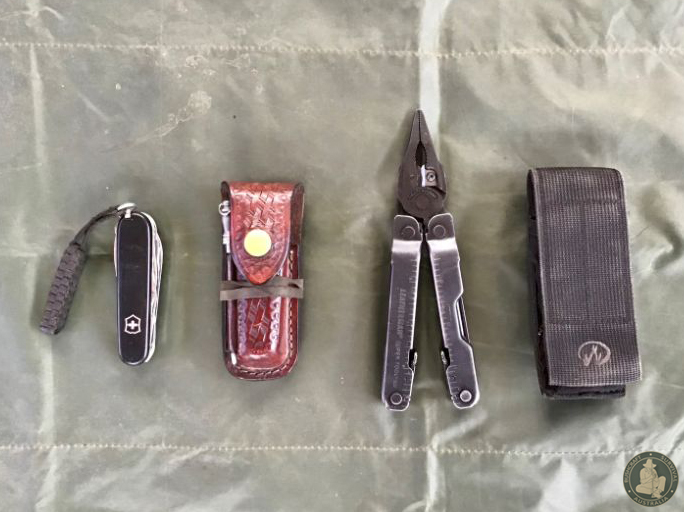
2. Combustion device (Ferrocerium Rod) If you don’t have a cigarette lighter or matches, the best thing you can have with you is a sparking tool such as a Ferro Rod, also known as a metal match or fire flash. This is a mixture of magnesium and different alloys that produces a hot shower of sparks when struck with an object that has a sharp 90 degree angle (eg. the back of a knife). It doesn’t give you guaranteed flame so you will have to learn how to find and prepare tinder in nature. To make fire from nature you will have to learn fire by friction.
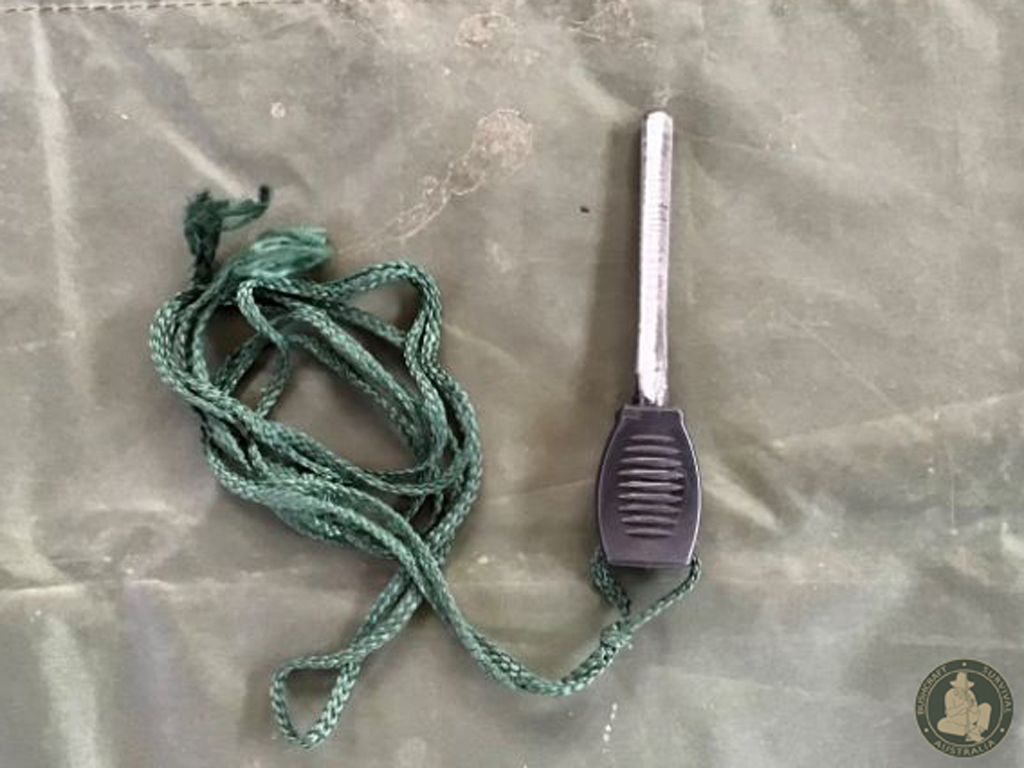
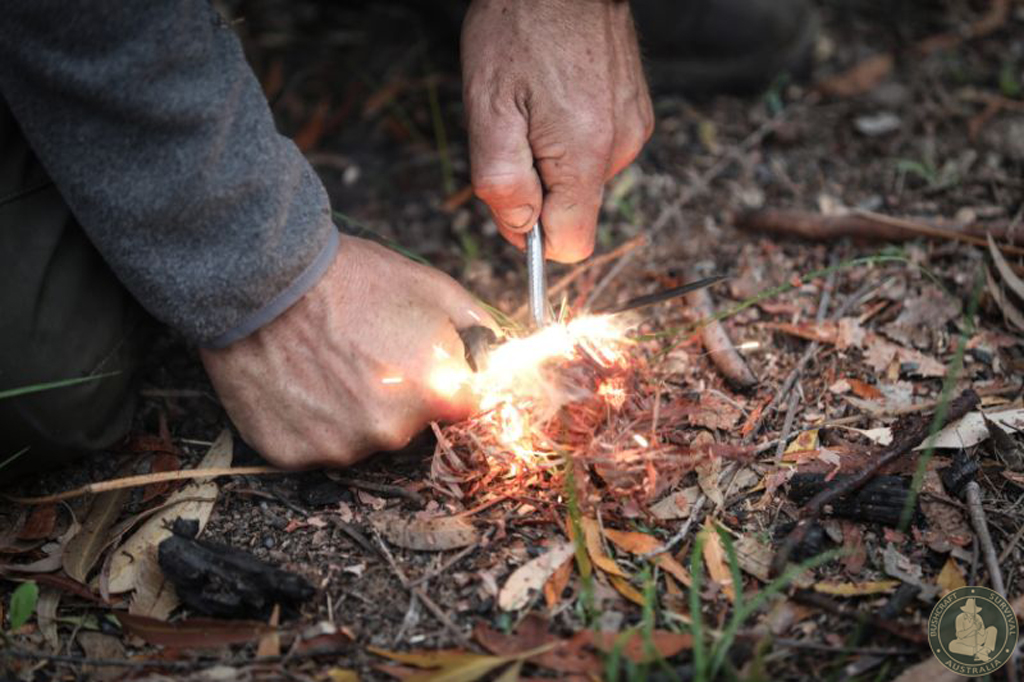
3. Covering or shelter. This could be a re-usable space blanket/tarp which reflects up to 70-80% of your body heat back to you or a large heavy duty garbage bag which can be used as a raincoat, moisture barrier, ground sheet, water carrier, filled with leaves for insulation, cut open and tied into a shelter. To make a shelter from natural materials (lean-to, wickiup, A-frame etc) is very time consuming and requires a lot of resources.
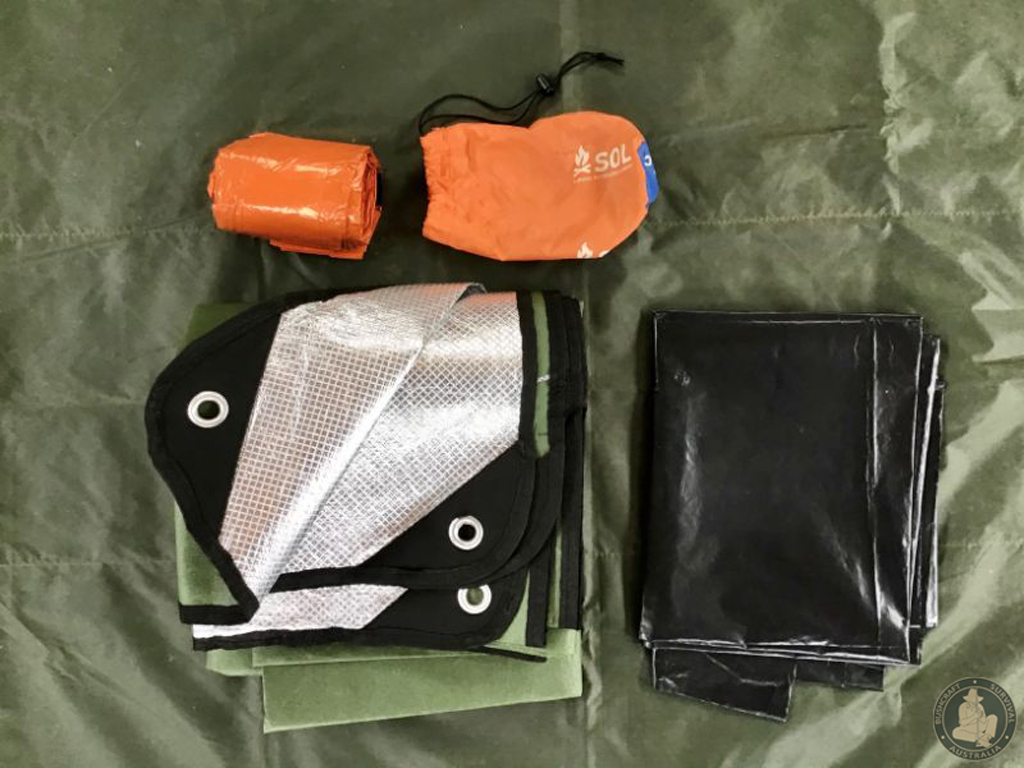
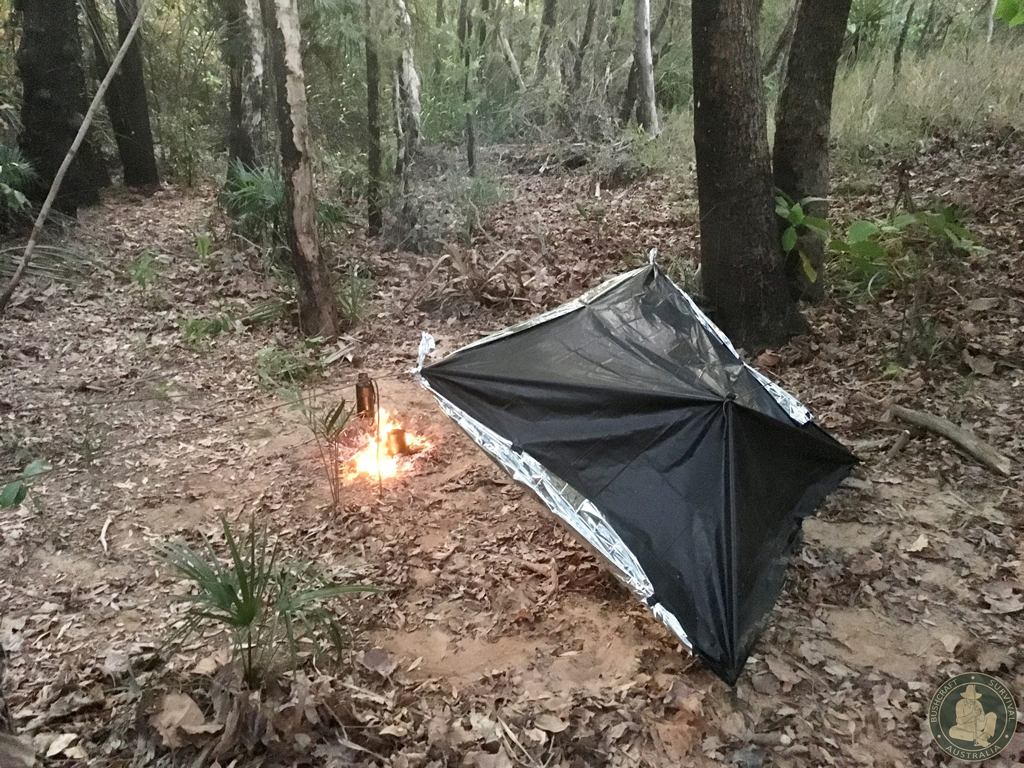
4. Metal container. Ideally pack a metal container and a nesting cup, as you need a way of carrying water as well as heating water. Boiling is the best way to ensure water is safe to drink. If you don’t have both, you should at least have a metal nesting cup to boil water in.
Kleen Kanteen make an assortment of good metal containers. To make a container from natural materials requires a knowledge of how to make a coal burned bowl, a folded paperback coolamon or bark containers, all which you can boil water in using hot rocks.
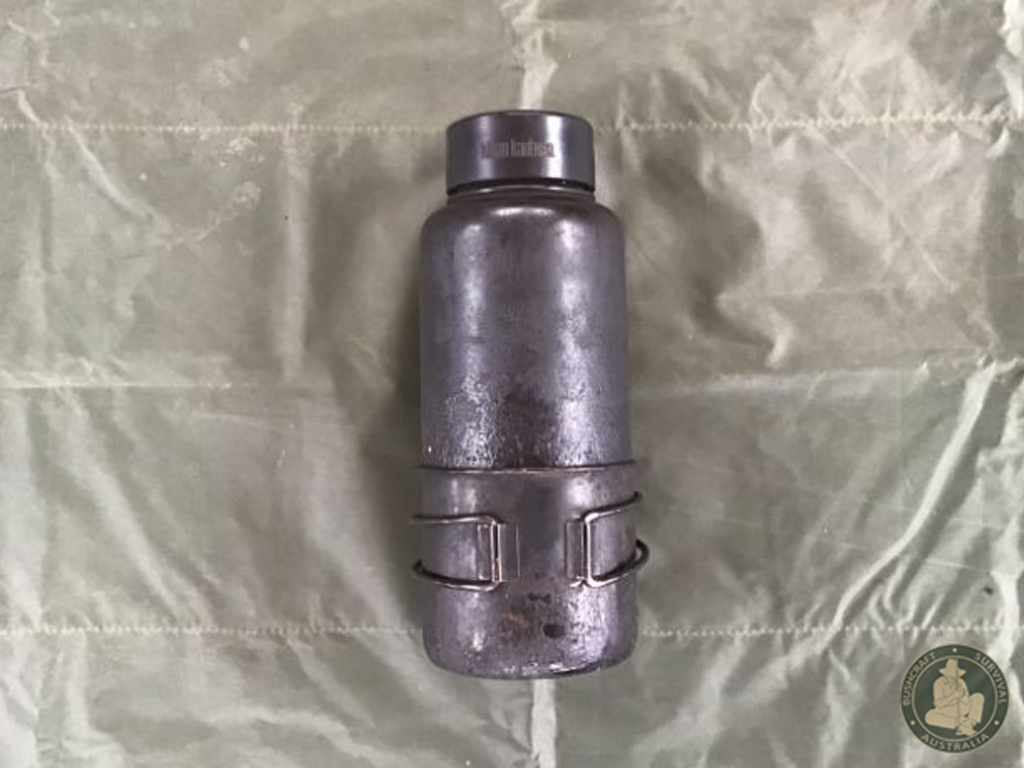
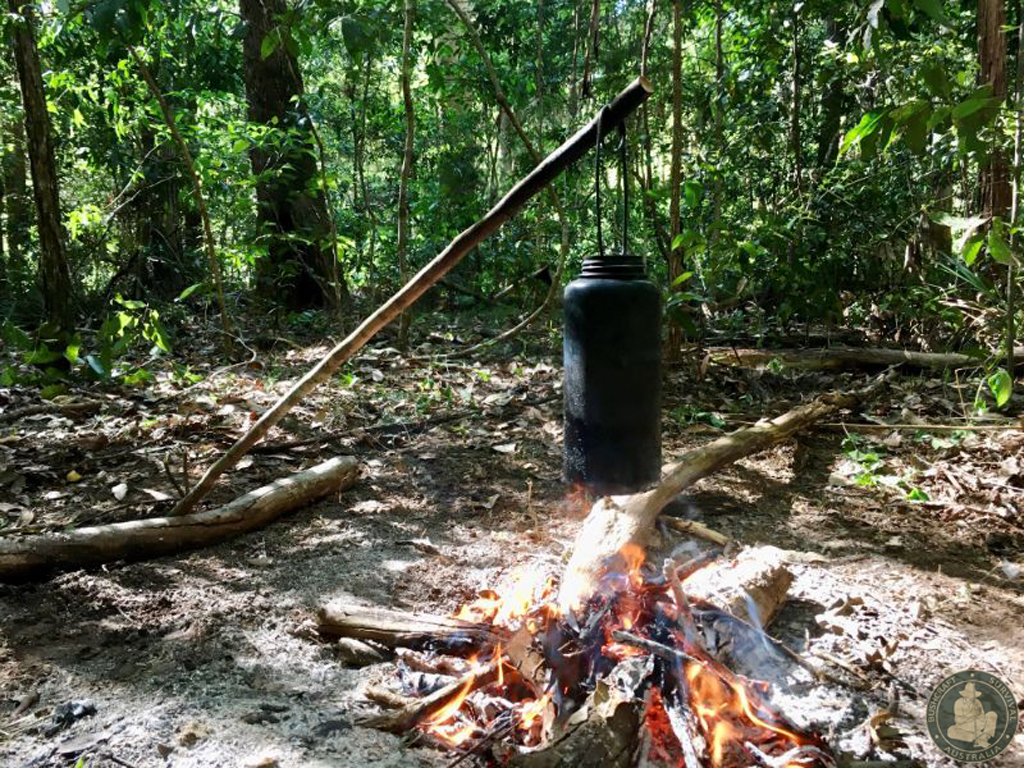
5. Cordage Parachute cord is the best as it has 7 inner strands and each one of these 7 strands can be broken down into 2 smaller fibres. If you break the cord down to these fibres, you can use them for fishing line, trap making and repair cord etc. To make cordage or string in nature is very time consuming and requires a knowledge of plant resources and string making.
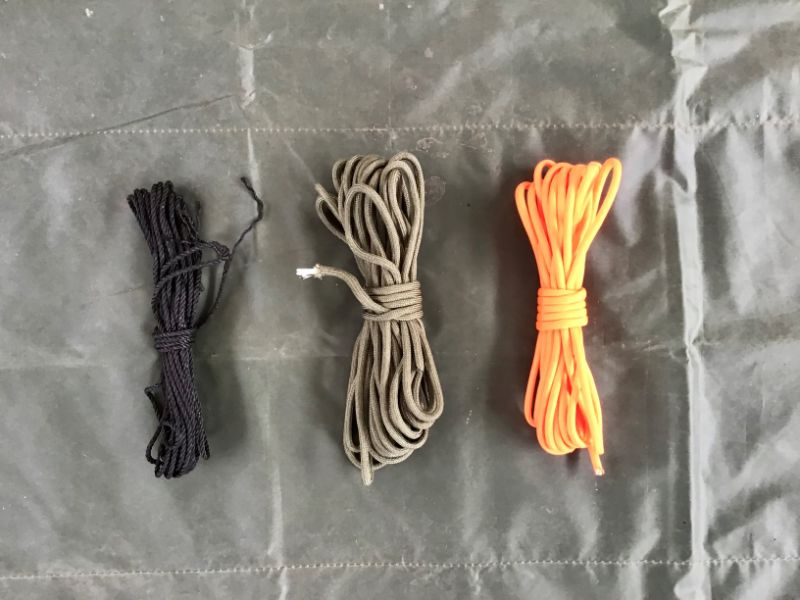
6. Compass This allows you to stay on course when moving from A to B and aids in direction finding. A “sighting compass” also has a mirror that can be used as a heliograph or for first aid. “Silva” make good quality compasses. If you don’t have a compass you will need to learn about natural navigation and finding direction from the sun, stars and other means.
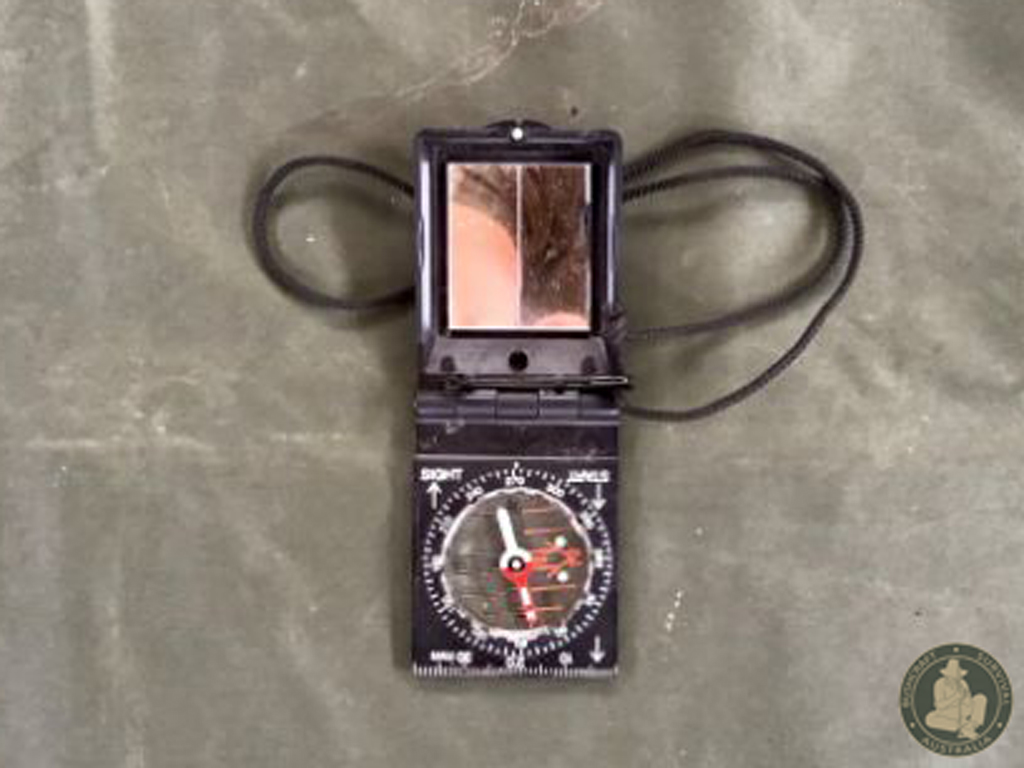
7. Cloth Bandanna This has multiple uses: head/neck scarf, filtering device, triangular bandage, sling, cordage, improvised bag, net, if 100% cotton can be used to make char cloth etc. An orange bandanna can also be used as a signalling device.
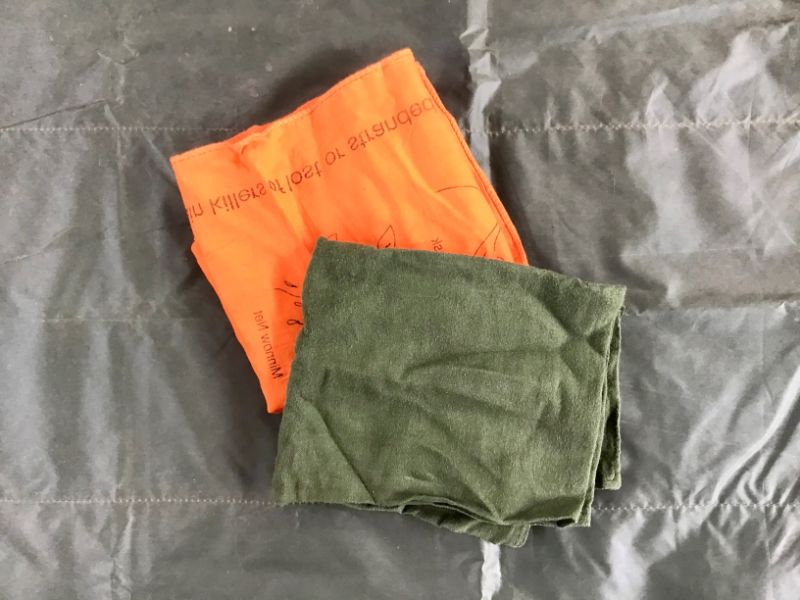
8. Duct tape used for mending things, water proofing, cordage, first aid, even to make an improvised water proof cup. A small roll of Gorilla tape is a good choice.
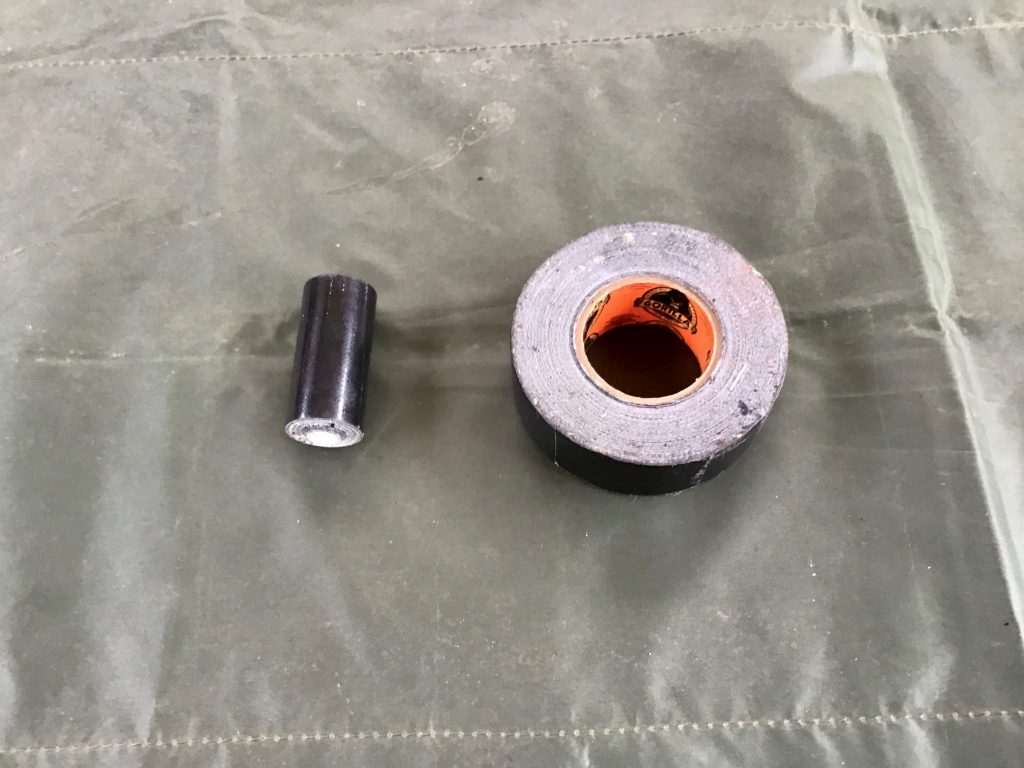
9. Head torch Used mainly as a light source but can also be used to make fire using the batteries and a piece of steel wool. “Ledlenser” make excellent head torches and portable lights.
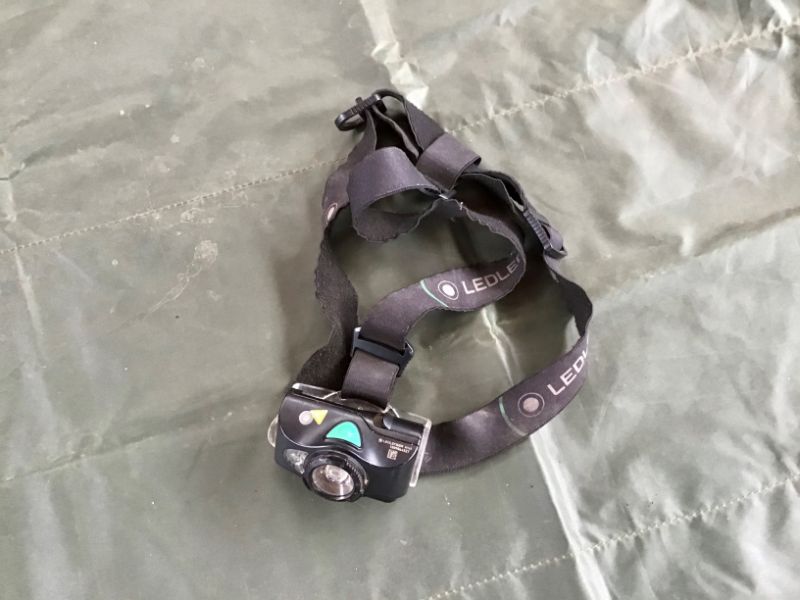
10. Small first aid kit This is personal choice but should have any prescribed medicines, items to deal with small cuts, scratches, bites and stings, iodine and alcohol preps, antiseptic ointment, small vial of Condees Crystals (Potassium Permangenate) and an assortment of needles including a cloth sail needle for kit repairs.
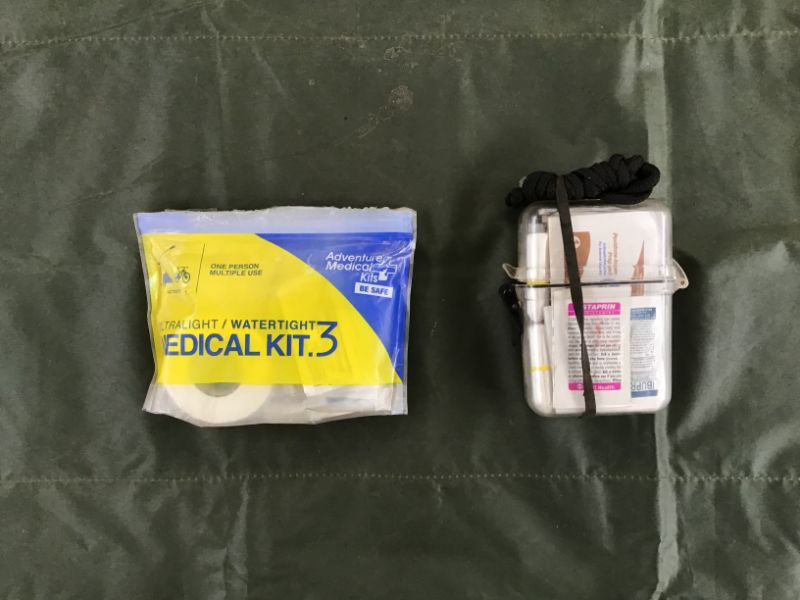
11. 5 Litre dry bag This can be used for water proofing, an extra water container or carry bag. “Overboard” make good quality dry bags.
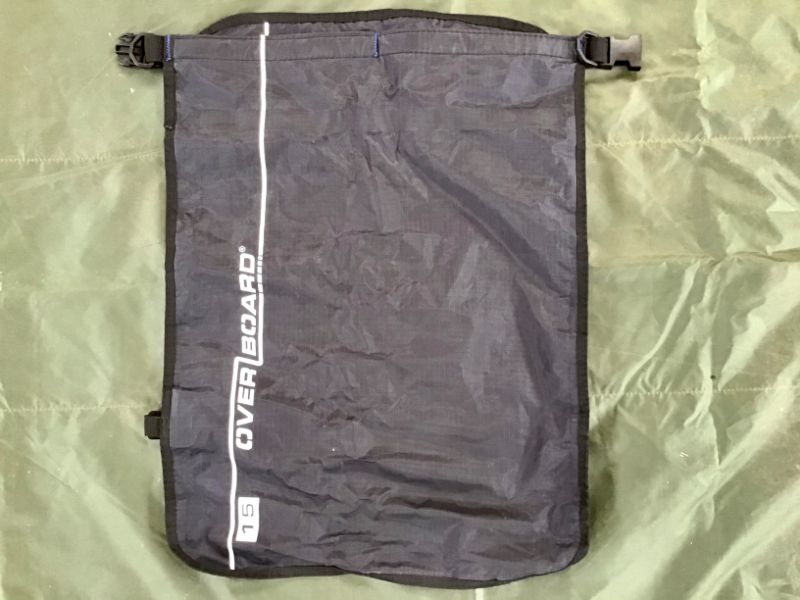
12. Small bag/pack A small day pack or bag to carry your items in. “Fjallraven” make durable small bags and mini packs that these items will fit into nicely.
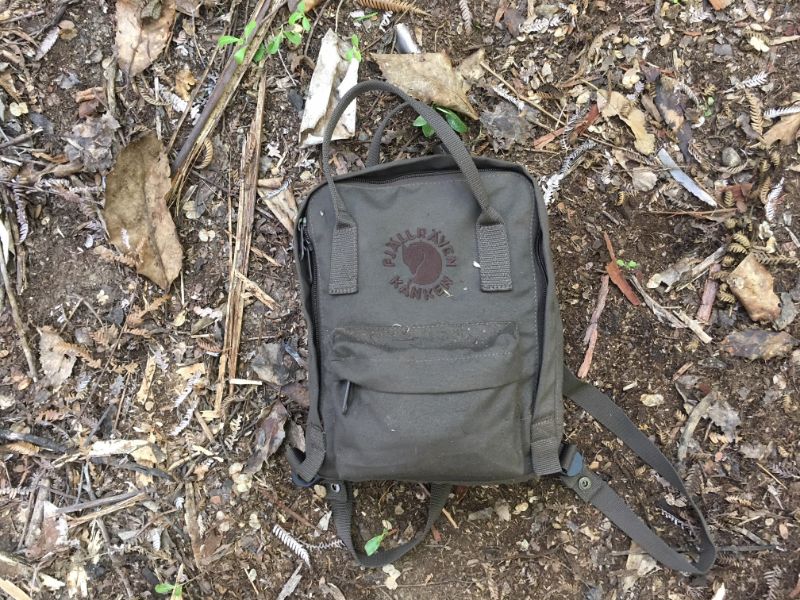
These 12 items are only suggestions and a base to build from and can be found in miniature in most military survival kits around the world.
Equipment is no substitute for knowledge which weighs nothing! The more you know, the less you have to carry!

This is a great list Gordon – very helpful to all who want to pursue this kind of activity.
Thanks Kathie, I’m glad you found this helpful.
i watch your videos and think that what you do is great encourage me to get outdoors and go camping during the school holidays
Hi Jack, that’s great to hear thank you! Cheers, Gordon
hi gordon sorry to bother you but i’m 13 years old and i was wondering if i’m old enough to do the Intermediate Module 3 Bushcraft Survival Course i do know a far bit about bushcraft thank you
Hi Jack, thank you for your question. Yes 13 is fine to participate on our courses provided you have parent supervision. As all our courses flow on from one another, it is advised that Modules 1 and 2 are completed beforehand as they are pre-requisites for module 3.
Warm regards
Gordon
Love this!! Especially the first two point about letting someone know where you’re going and when you’ll be back. If anything this is the step you must not miss-people need to know you’re missing if they’re ever going to find you.
Love how I can pack a pack (lol) with just 12 items and know I’m prepared for any situation.
Thanks Nat, I’m glad you found this helpful. It’s only a guide line though as everyone will have their own versions. More importantly is that people need to know how to use the equipment and how to improvise if they don’t have it.
Thanks for the feedback.
Hi Gordon, great info. I discovered you site after enjoying many of your YouTube clips. I have to confess that of late i have been getting out my tin foil hat due to these troubled times re covid 19 and the financial and political instability. I would like to know if you would change or add anything to the above mentioned 12 in setting up a bug out bag for NSW. Thanks
Hello Tony,
Thanks for your enquiry. These 12 items are only a guide. They continue to a 15 piece kit and a 20 piece kit mainly including extra tools such as a multitool, folding saw, mil bank bag and comfort items such as tarp shelter, sleeping bag, 3/4 sleeping mat, bivvi bag, ground sheet, small cooking pot etc.
We do this in Scotland too when going hill walking. Alas too many folk fail to do thus bringing not only themselves but also the rescue services in danger…
Sadly the “she’ll be right” attitude persists everywhere and people don’t think to prepare accordingly and think ahead.
Great list with a good explanation of different purposes for each item. I am building a day pack for going bush and this guide has given me a few ideas to work on to be a better all-rounder.
I’m glad you found the article useful. It’s only a guide though, you can supplement where necessary to suit your personal needs.
A good article Gordon.
I like to tell people they need to let someone with an invested interest in them know when they go out, unfortunately Australia has had people die because the person they told had forgotten about them, also worth noting the person they tell does not have to be local they could be in another country, with modern technology they can raise the alarm from anywhere in the world.
I look forward to your next article.
Thats right Justin, it has to be someone you trust and who is reliable. A game plan of what to do once an agreed timing (schedule) is missed is also important. Thanks for your continued support mate.
Wonderfully simple article. Cuts right to the chase without ego, waffle or gadgets. Again great work Gordo.
Thanks Johnno, I really appreciate the honest feedback and your continued support.
Hi Gordon, I noticed in your 12 essential items that you didn’t include water IN the bottle which doesn’t take up extra space. Other things that I would consider essential that don’t take up much weight, space or effort would be: couple of nut/muesli bars, a BIC lighter, cotton balls or drier lint for tinder.
Since many people carry a mobile phone, maybe they should load it with survival skills apps such as Compass, Trails (which shows where you have been and where you are) or even Google Maps which gives satellite navigation. All these are free and simple to use.
I even have a mobile version of SAS Survival Guide. I agree that knowledge is the best form of survival tool.
I’m assuming you are having a little joke, it would be assumed that the water bottle would be filled with water! Kit lists and survival kits are subjective and up to personal discretion and choice. There are numerous combinations you could have, as long as you tick off the important survival priorities of shelter, warmth, fire, water and signalling. For a short day hike, food is not an essential item, it’s a nice to have and certainly a priority in a longer scenario. Most people would naturally carry some snacks on a day hike anyway. This is only a bass line guide. I appreciate your input.
Hi Gordon,
This is a great list that I am slowly building for myself and hoping to do your 3 day course in Sydney around October.
I’ve found it near impossible to find 1m x 1m cotton bandanas or plain Colour Shemaghs in orange and olive . Do you know anywhere online that sells them or do you sell them yourself ? There seem to be a lot of cheap Shemaghs that as basically cheese cloth, or he rothco ones (can’t get the right colours) end up costing about $35 each.
Cheers
Hello James, as luck has it we have just designed a 100% cotton bandana with all the uses listed on it in diagrammatic form. You can purchase these through Survival Supplies Australia but we will also have them for sale and use on our courses.
Gordon
G’day Gordon,
I’ve watched plenty of your youtube videos and booked myself into your next available Sydney course and can’t wait to learn some of the practical, tangible and realistic survival skills form both you and your team.
All the best,
Tony
Hello Tony, I’ve only just got around to reading this. Thanks for attending the 3 day basic course and I hope you got a lot from it. It was a pleasure having you there and hope to see you on our Intermediate course one day. Stay in touch.
Gordon
Hi Gordon,
Found your site via a search for info on bush knives, looking for one as a birthday present for my son.
When I asked him if he had a preference he had the sense to say that there were way too many options and he didn’t know where to start but that he would trust my judgement… Thanks to you we will both soon have Mora Bushcraft Black knives with the MOLLE sheath with ferro striker and built in diamond sharpener.
Your advice is structured and logical and I especially like how it identifies both the key requirements and the deficiencies of those to be avoided and why.
Have subscribed to your channel, looking forward to following with interest, even if I don’t get as much these days as I used to.
The Mora knives are generally great knives for Bushcraft use and very affordable.
The Bushcraft Black Tactical is a better choice than the Bushcraft Survival Black with the diamond sharpener on the sheath as the sharpener is too small I feel. Purchasing a separate Ferro rod that can be stored on a lanyard in your pocket is also a better option.
The HD MG Companion is also an excellent knife that we issue on our courses as do many Bushcraft schools, however it does not come with a 90 degree spine. It’s easy enough to put one on with a file though.
Glad the article was of help. Thanks for reading.
Did you forget – a map. More essential than some items you list.
When fire ban applies – water purification tablets.
Hi Chris, yes a map is an essential item to take but it was not included as it is assumed that you would have a map of the particular area you were going to to go with the compass if you were navigating, just like it is assumed you would be wearing clothes or have water in your water bottle.
Yes, when it is not safe or practical to light a fire, chemical sterilisation is an option.
Gordon
Great list Gordon.
I remember back to the classic Survival acronym. The first letter is “Stop and Think”. A number of the others are related to slowing down and being deliberate with your actions, energy, time and resources.
From this I have made a “Stop & Think Tin”. I took inspiration from the “extras” in RATpacks (I know you love these!). It is an old tobacco tin and has basic items to assist with calming down, pausing and considering your situation plus a few bits to make surviving easier. It contains tea/coffee, sugar, salt, sports drink powder, an oxo cube, chewing gum, aquatabs, storm matches, foil and a meusli bar.
I include this tin as important as the other items you’ve listed to ensure ones head is in the right place in the event your “surviving”.
I also this an EPIRB or PLB is very important to be sure you’re found. I know you shouldn’t rely on technology but it’s such an effective way to being found.
Hope this helps….
It would be great if your team put packs of these essentials together for sale. That would be a very helpful service and I would buy sets for each person in my family and be happy to pay extra to have it sourced for me.. It’s figuring it all out, knowing where to get and what quality to get etc. Anyway, hope to get to a course soon.
Highly competent and effective, yet selfless and generous with your expertise. Australia needs more people like you. Love your work, Sir